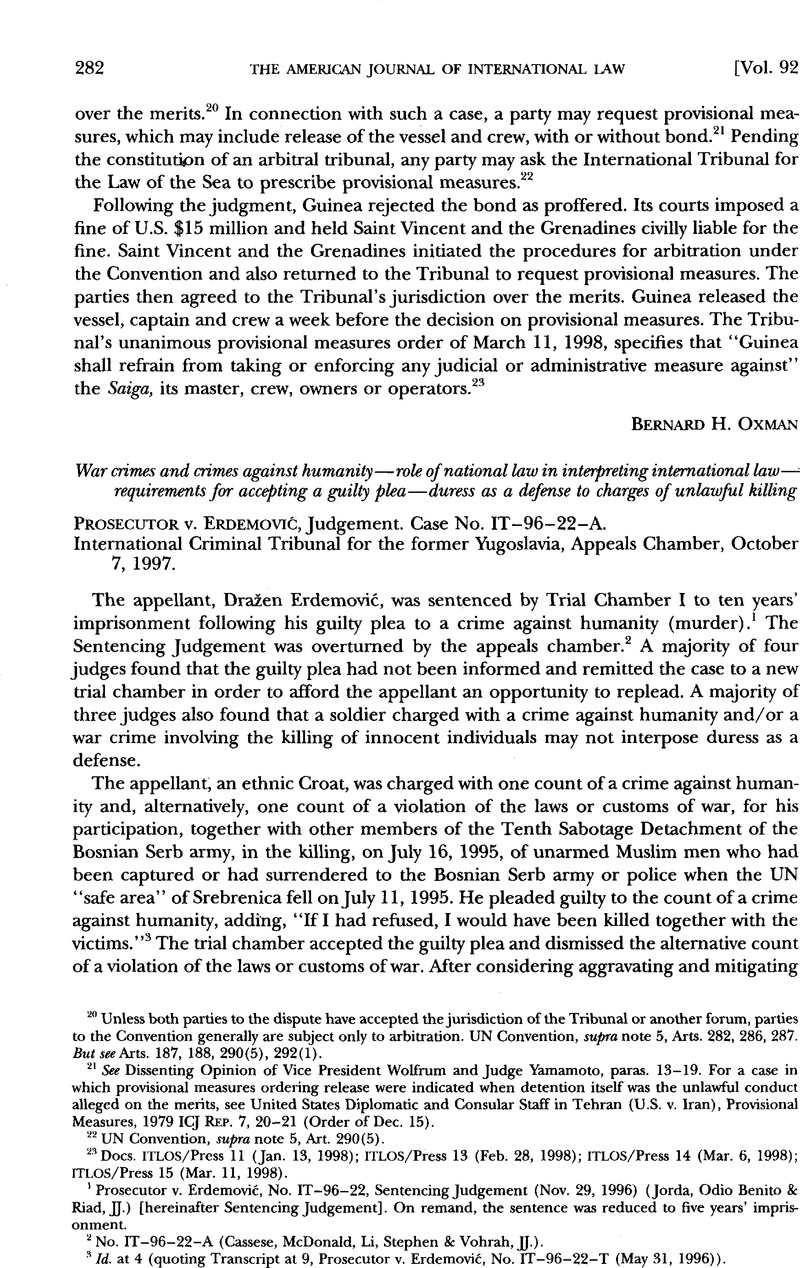Article contents
Prosecutor v. Erdemović, Judgement
Published online by Cambridge University Press: 27 February 2017
Abstract

- Type
- International Decisions
- Information
- Copyright
- Copyright © American Society of International Law 1998
References
1 Prosecutor v. Erdemović, No. IT–96–22, Sentencing Judgement (Nov. 29, 1996) (Jorda, Odio Benito & Riad, JJ.) [hereinafter Sentencing Judgement]. On remand, the sentence was reduced to five years’ imprisonment.
2 No. IT–96–22-A (Cassese, McDonald, Li, Stephen & Vohrah, JJ.).
3 Id. at 4 (quoting Transcript at 9, Prosecutor v. Erdemović, No. IT–96–22-T (May 31, 1996)).
4 Sentencing Judgement, supra note 1, paras. 84–91.
5 International Tribunal for the Prosecution of Persons Responsible for Serious Violations of International Humanitarian Law Committed in the Territory of the Former Yugoslavia since 1991 [Tribunal], Statute, UN Doc. S/25704, annex (1993), 32 ILM 1192 (1993).
6 Tribunal, Rules of Procedure and Evidence (Feb. 11, 1994), 33 ILM 484 (1994), as amended (July 25, 1997), UN Doc. IT/32/Rev.11 (1997).
7 Vienna Convention on the Law of Treaties, opened for signature May 23, 1969, Art. 31, 1155 UNTS 331.
8 No. IT–96–22-A, Separate Opinion of Judge McDonald and Judge Vohrah, para. 5 (citing Exchange of Greek and Turkish Populations, 1925 PCIJ (ser. B) No. 10, at 19–20 (Advisory Opinion of Feb. 21)).
9 Id., para. 8.
10 Id.
11 Id.
12 Id., para. 20.
13 They refer to the International Court of Justice’s North Sea Continental Shelf Cases (FRG v. Den.; FRG v. Neth.), 1969 ICJ Rep. 3, paras. 73–81 (Feb. 29), for the proposition that, for a rule to become part of customary international law, there must exist “extensive and uniform state practice underpinned by opinion juris sive necessitatis.”
14 Austria, Belgium, Brazil, Greece, Italy, Finland, the Netherlands, France, Germany, Peru, Spain, Switzerland, Sweden and the former Yugoslavia.
15 The U.S. exception relates to the adoption by several states of §2.09 of the United States Model Penal Code, which provides that duress is a general defense to all crimes.
16 The judges also questioned the international character of the post–World War II military tribunals constituted under the London Charter and Control Council Law No. 10, noting that insofar as these tribunals considered the issue of duress, for which there was no guidance in international law, they invariably drew from the jurisprudence of their own national jurisdictions.
17 Including the penal laws of France, Belgium, the Netherlands, Spain, Germany, Italy, Norway, Sweden, Finland, Venezuela, Nicaragua, Chile, Panama, Mexico and the former Yugoslavia.
18 Including the penal laws of England, the United States, Australia, Canada, South Africa, India, Malaysia and Nigeria.
19 Including the penal laws of Japan, China, Morocco, Somalia and Ethiopia.
20 Separate Opinion of Judge McDonald and Judge Vohrah, supra note 8, para. 66.
21 Id, para. 75.
22 Id.
23 Id., para. 83.
24 Id., para. 80.
25 Id., para. 85.
26 Namely, that (1) the act was taken to avoid an immediate, serious and irreparable danger; (2) no other adequate means to escape existed; and (3) the remedy was not disproportionate to the evil.
27 No. IT–96–22-A, Separate and Dissenting Opinion of Judge Li, para. 5.
28 Id., para. 8.
29 Id., para. 11.
30 No. IT–96–22-A, Separate and Dissenting Opinion of Judge Cassese at 3.
31 Id. at 13.
32 Id., para. 10.
33 Id. at 3.
34 Id., para. 11.
35 The conditions are that (1) the act charged was done under an immediate threat of severe and irreparable harm to life or limb; (2) there was no adequate means for averting such evil; (3) the crime committed was not disproportionate to the evil threatened; and (4) the situation leading to duress must not have been voluntarily brought about by the person coerced. When it cannot be admitted as a defense, duress may nevertheless be considered as a factor in mitigation.
36 No. IT–96–22-A, Separate Opinion of Judge Stephen, para. 26.
37 Id., para. 33 (citing 1 LORD HALE, PLEAS OF THE CROWN 51 (1800)).
38 Id., para. 64.
39 Such an application is, in fact, advocated by Judge Cassese, who highlights its particular relevance to warlike situations.
- 3
- Cited by


